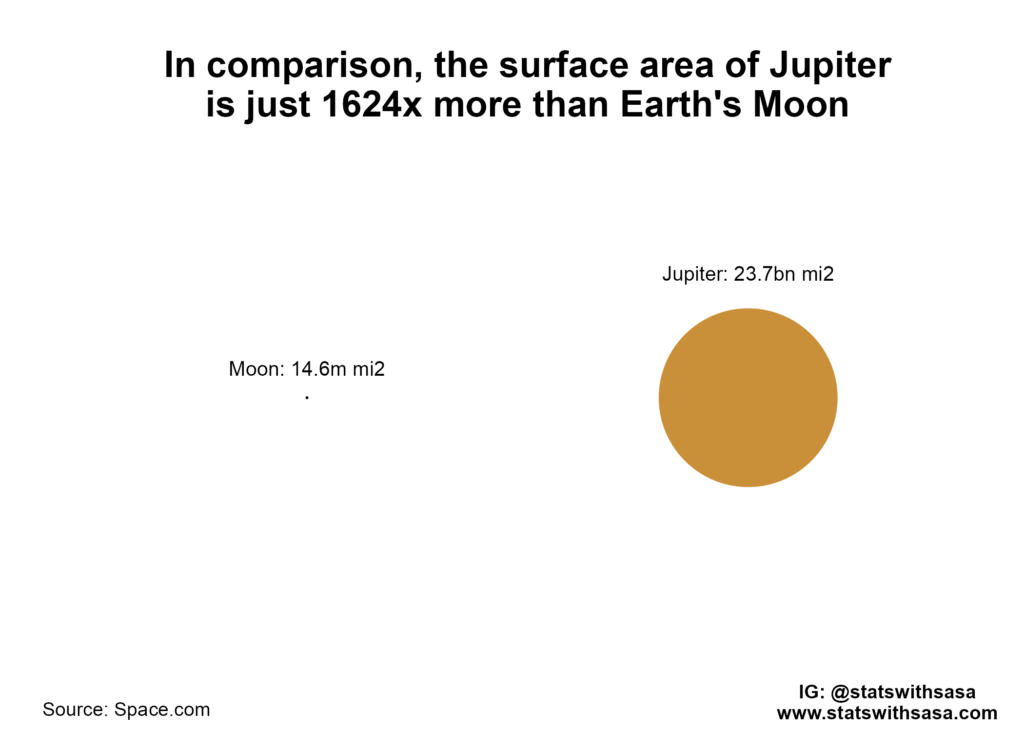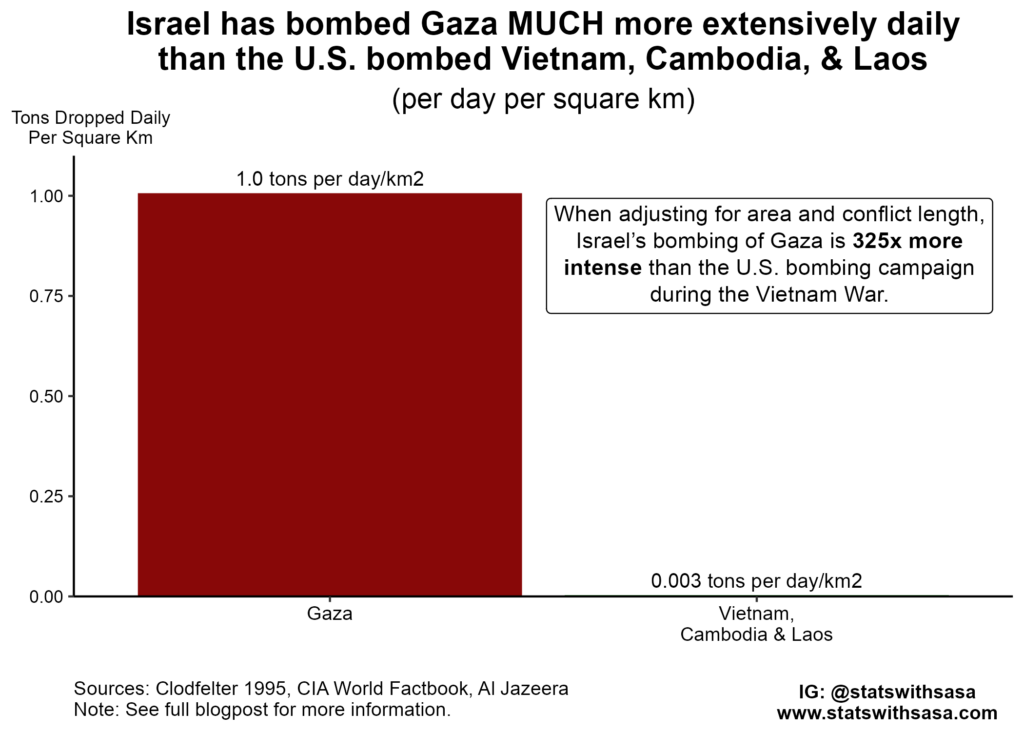A popular narrative is floating around the internet: over the last ~200 days, Israel has dropped more bombs on Gaza than dropped during the entirety of WW2.
This narrative likely stems from an analysis that shows that the tonnage of bombs dropped on Gaza has already surpassed that dropped on London, Hamburg, and Dresden combined — three of the most heavily bombed cities during WW2 (and human history in general). This fact is undeniably true. However, this narrative has twisted into the claim that “Israel has dropped more bombs on Gaza than the entirety of WW2”. This claim is undeniably false, and also a little ludicrous in my opinion.
That being said, it is an unavoidable fact that Israel is bombing Gaza at a devastating rate. In this post, I will compare Israel’s bombing campaign of Gaza to some of the most catastrophic bombing campaigns in human history — namely the Vietnam War. In 10 years of conflict, the U.S. dropped over seven and a half million tons of bombs on Vietnam, Cambodia, and Laos. These countries were so heavily bombed that to this day, over 50 years later, they still deal with millions of unexploded ordnance that endanger civilians. How does Israel’s bombardment of Gaza since October 7th compare?
I will walk through various comparisons of Gaza to past bombing campaigns. Click below to skip ahead.
Total bombs dropped
First, let’s compare the total tonnage of bombs dropped across the conflicts. In this chart, I compare Gaza to three of the largest U.S. bombing campaigns: the Vietnam War, the WW2 European Theater, and the WW2 Pacific Theater.
Note: I use a figure of 75,000 tons of bombs dropped provided by Gazan sources. This broadly compares to other, earlier, sources provided by the U.N. It is actually likely a conservative comparison because this figure is likely given in metric tons, which are larger than U.S. tons.

This chart does a really good job of encapsulating the absurdity of any claim that the bombing of Gaza compares to WW2 in absolute terms. It doesn’t even compare to the munitions expended by the U.S. Air Force in a single theater of the war.
However, I don’t think this is a fair comparison. For starters, each of these comparisons were multi-year conflicts. The conflict in Gaza has lasted “only” ~200 days, compared to 1,000+ days for the European Theater and 3,300+ days for the Vietnam War. To better encapsulate the comparative intensity of each bombing campaign, we should look at things in daily terms.
Bombs per day
Let’s normalize our earlier chart to account for how long each conflict lasted.

This chart shows that in daily terms, Israel’s bombing of Gaza is comparable to some of the most devastating bombing campaigns in human history. In fact, it approximates the ordnance we dropped in the Pacific Theater every day. And that was against a highly sophisticated and advanced army that had conquered vast swathes of Asia. In comparison, the campaign in Gaza is against an overwhelmingly civilian population.
Speaking of vast swathes of Asia, there’s another thing I think we need to account for if we truly want to capture the intensity of Israel’s devastation of Gaza. Gaza is tiny. Geographically, Gaza is the size of Philadelphia. Yes, you read that right:
Israel is bombing an area the size of Philadelphia with the same amount of ordnance as the U.S. in the entire Pacific Theater of WW2.
Size does matter
Like I mentioned earlier, the Gaza Strip is tiny. It’s hard for the human brain to comprehend just how small Gaza is compared to the areas bombed by the U.S. in the Vietnam War. I use current borders of Vietnam, Cambodia, Laos, and Gaza to help visualize the difference in size that we’re talking about.
Note: From now on, this post focuses on a comparison to the Vietnam War.

That tiny dot is Gaza, compared to the large green circle representing the area of Vietnam, Cambodia & Laos. That’s a 2,081x difference in size. Let’s take this comparison a step further.

That’s right. The difference in area between Gaza and Vietnam, Cambodia, & Laos is actually larger than the difference between the Solar System’s largest planet and Earth’s Moon.
Total bombs dropped adjusted for area
Okay, it’s clear that we need to adjust our prior analyses to account for the size of each area bombed if we want to truly capture the intensity of each bombing campaign. Let’s begin by looking at total tonnage of bombs dropped per square kilometer.

This is the most damning chart yet. When we account for bombs dropped per square kilometer, we reach the following conclusion:
Since Oct. 7th, Israel has dropped 20x more bombs per square kilometer in Gaza than the U.S. dropped during the entire Vietnam War.
Bombs per day adjusted for area
The above chart compares bombs per km2 in a ~200 day conflict against bombs dropped during a 9-year conflict. Let’s make a final adjustment for the length of each conflict.

When we adjust for conflict length, the difference becomes all the more stark. If we adjust for conflict area and length, we conclude the following:
Israel’s bombing of Gaza is 325x more intense than the U.S. bombing campaign during the Vietnam War, which is considered by many to be one of (if not the most) intense bombing campaigns in human history.
Conclusion
Israel’s devastation of Gaza has been total. In fact, when we compare the tonnage of bombs dropped in Gaza, we see that in some ways it is more intense than the U.S. bombing campaign during the Vietnam War. As a reminder, the U.S. bombing campaign during Vietnam is widely considered one of the most devastating bombing campaigns in human history. In fact, major news outlets often consider Laos to be “most heavily bombed country in the history of the world.” The fact that Israel’s bombing of Gaza is even in the same neighborhood is truly astounding. In fact, we can reasonably conclude:
Israel’s bombing of Gaza is arguably more intense than the U.S. bombing campaign during the Vietnam War when adjusting for area and conflict length.
Despite this provably historic destruction, there are few signs it will stop anytime soon. Through it all, President Biden has continuously and emphatically stated his support for Israel’s devastation of Gaza. Supporters of Biden may point to weak lip service and his pausing of a single arms shipment to Israel as evidence that he does not fully back Israel.
But to this day, Biden has shown with words and actions that there is no true red line for Israel. As recently as June 17th, his administration placed intense pressure on key Democrats to sign off on a major arms sale to Israel. It’s unavoidable: the wholesale slaughter and historic devastation in Gaza is becoming a key part of Biden’s legacy. Whether he finally decides to do the right thing and place real pressure on his Israeli counterparts to stop this madness remains to be seen. We can only hope.
If you enjoyed this post and want to see more, don’t forget to subscribe below:

Sorry for the typo error in my preceding comment. Here’s the corrected version.
Brilliant! The numbers and comparative analysis are quite convincing!
May I suggest that you apply the same methodology/analysis comparing the atomic bombing of HIROSHIMA and NAGASAKI in 1945 to the Israeli bombing of GAZA (based on the area, population and duration). Nobody has done this and your work will be a major contribution.
I’d greatly appreciate your findings on the issue I raised and will include them in the scholarly paper I’m writing.
Many thanks for your valuable work.
Comment awaiting moderation.